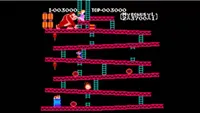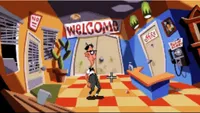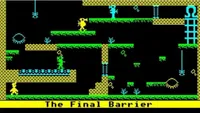Best retro games: the best classic video games around
When old is gold, these are the best retro games that make us misty eyed.


Give me 16-bit pixels or give me death!
We're living in the 4K-HDR-photo-real golden age of videogames, spoilt for choice with PS5 hits and Xbox Series X gems, with an incredible range of interactive experiences to suit every taste. So why do we keep going back to NES-era platforming classics? Polygonal PS1 horrors? Coin-op beat-em ups?
It’s hard not to occasionally pine for the simpler days of gaming's yesteryear, when the best retro games - those fantastic 8-bit and 16-bit titles - turned us into the healthy, sleep-shirking addicts we are today. No paid-for DLC, no hours-long waits for game-breaking update patches, no kids halfway around the world slagging off our dear mums during an online match up. Just a quick blow on the catridge slot and hours of gaming bliss awaited.
Without further ado, here are the best retro video games that we still can’t get enough of. Where possible we've added links to let you play these old gems on modern hardware.
Upvote your favourite retro games and use the suggestion box at the bottom to add games you think deserve a place in this hall of fame.
- The best retro games console revealed
Best retro games
NES, 1993 (Super Mario All-Stars)
Having pretty much invented the platform game, Nintendo reinvented it with the secret-packed Super Mario Bros. 3, then repeated it with Super Mario World. The two best side-scrollers of all time, it’s a heck of a job to separate them. The sprawling ambition of Super Mario Bros. 3 or the invention of Super Mario World? The Frog Suit or Yoshi? The Super Leaf or the Cape Feather? We’ve plumped for SMB3, but they’re so close to gaming perfection, there’s nothing in it.Image Credit: Nintendo
SNES, 1992
If Super Metroid taught us to fear the unknown, Link’s epic quest made it exciting again. A top-down Hyrule rammed with secrets and surprises, it’s a delight to explore. Not least when you figure out how the light and dark worlds slot together. Unlike these days where you’re given a nudge if you stray too far, here you’re encouraged to get gloriously, hopelessly lost – and you’ll have a whale of a time doing so.Image Credit: Nintendo
Arcade, 1992
It’s smoky arcades filled with old cabinets that have been left scarred from cigarette burns, and unused credits sliding down onto floors that are perpetually sticky with cheap, stale booze. It’s teaching friends how to do the perfect dragon punch motion. It’s beating that bigger kid by doing Blanka’s electric attack. It’s unlocking Akuma and then immediately losing half of your life bar within seconds. Turbo might be the definitive version of Street Fighter II, but whichever one you played, the memories will no doubt still vividly linger.Image Credit: Capcom
Nintendo Gameboy, 1989
It’s odd to think that a game centring on finding the best way to successfully arrange a group of coloured blocks should have been at its best when played on a machine that was incapable of displaying more than four shades of greenish-grey. But, regardless, the Game Boy version of Alexei Pajitnov’s opus was simply the perfect match between game and hardware.Image Credit: Nintendo
Sega Mega Drive, 1992
Sega’s spiny speed merchant proved himself a worthy rival to Nintendo’s Mario with his Mega Drive debut. Yet it was the spectacular loops, corkscrews and clever environmental tricks in the follow-up that proved his makers carried the same swagger. With co-op partner Tails in tow (whose real name, Miles Prower, is one of gaming’s best dreadful puns) this blistering adventure was one of the finest two-player games of the 16-bit era and still leaves many of the modern Sonic games for dust.Image Credit: SEGA
Arcade, 1981
The game that launched the career of a certain plumber, Nintendo’s 1981 arcade hit was pivotal. Having failed to crack the US, president Hiroshi Yamauchi convinced young designer Shigeru Miyamoto to create a new game. Jumpman (renamed Mario, after the US arm’s landlord, for the game’s Stateside launch) and his simian nemesis gobbled enough quarters to keep Nintendo afloat and launch countless Kong spinoffs (pictured). The rest is history.Image Credit: Nintendo
SNES, 1992
While everyone has their favourite Mario Kart – from the four-player-thrills of Mario Kart 64 to the weaponised mayhem of Double Dash!! – few would deny the SNES game’s claim to top spot. It’s aged beautifully – and, unlike many of its successors, every victory is hard-earned. Gaming’s finest spin-off.
Image Credit: Nintendo
Arcade, 1978
Forget Gears Of War, Taito’s 1978 classic was the first cover shooter, as you attempt to fend off an extraterrestrial force. Your pulse would quicken along with the music as the aliens came closer, while blasting the flying saucer was as satisfying as a Call Of Duty headshot.Image Credit: Atari
SNES, 1994
There aren’t many games to have ever captured the sense of bleak isolation as expertly as this SNES classic. As bounty hunter Samas Aran dropped into a desolate world, it’s an homage to Alien, evoking the same gnawing tension as Ridley Scott’s cinematic horror, while the brooding, synth-led soundtrack prompted further shivers.Image Credit: Nintendo
Sega Mega Drive, 1992
Two players, two pads, too many fizzy drinks: the only way to play Sega’s bruising brawler was with a partner. It was a rival to Capcom’s Final Fight, but this game definitely had the edge, which was partly due to Yuzo Koshiro’s particularly memorable score.
Image Credit: SEGA

NES, 1984
A precursor to the modern first-person shooter, Duck Hunt didn’t allow you to blast zombies, mutants or even mutant zombies. But lowering the waterfowl population was just as satisfying. Perhaps it was the bundled NES Zapper – one of the finest lightguns we’ve wielded. Or maybe it was the chance to wipe the smirk off of that dog’s face.
Image Credit: Nintendo
Arcade, 1982
Ms. Pac-Man is the arcade original, but with more added in.
It introduced new maps and was harder: and it made the yellow gobbler the most successful US-produced coin-op.
Image Credit: Atari
Arcade, 1985
This Atari masterpiece had four players crowd around a cabinet to finish its labyrinthine levels. This situated you perfectly for elbowing someone in the ribs if they ignored advice about shooting food.
Image Credit: Midway
Arcade, 1972
Atari’s take on table tennis brought the medium into the mainstream, but aside from its importance to the industry, it’s a great game in its own right. Two dials, two bats, one ball: it still works now.Image Credit: Atari
MS-DOS, 1993
No retro list would be complete without a classic point-and-click adventure, and there’s none finer than Tim Schafer and Dave Grossman’s barmpot sci-fi. Tipping its cap to Fifties monster movies and Chuck Jones cartoons, its time-travel plotline affords you bizarre pleasures. Uproariously silly.Image Credit: LucasArts
Amiga and MS-DOS, 1992
For a certain generation, football rivalry wasn’t just between Fifa and Pro Evo. It was the pace and banana shots of Kick Off versus the sharp passing game of Sensible Soccer. For our money, Sensi wins: it gave a glimpse at tiki-taka way before Barca made it fashionable.Image Credit: Sensible Software
ZX Spectrum, 1985
If you think modern games are too easy, this Spectrum hit is the remedy. All 20 screens host a clutch of wild and unpredictable hazards. If it was released now, it would have an easy mode and a dubstep soundtrack; best stick with the original.Image Credit: ZX Spectrum
ZX Spectrum, 1983
Played at a faster pace than Donkey Kong, Chuckie Egg required pixel-perfect leaps. It was home grown, intense and satisfying.Image Credit: Elite Systems
SOMETHING MISSING FROM OUR SHORTLIST?
Tell us about it, and if enough people agree we'll add it in.
Get exclusive shortlists, celebrity interviews and the best deals on the products you care about, straight to your inbox.

As Content Director of Shortlist, Marc likes nothing more than to compile endless lists of an evening by candlelight. He started out life as a movie writer for numerous (now defunct) magazines and soon found himself online - editing a gaggle of gadget sites, including TechRadar, Digital Camera World and Tom's Guide UK. At Shortlist you'll find him mostly writing about movies and tech, so no change there then.


















